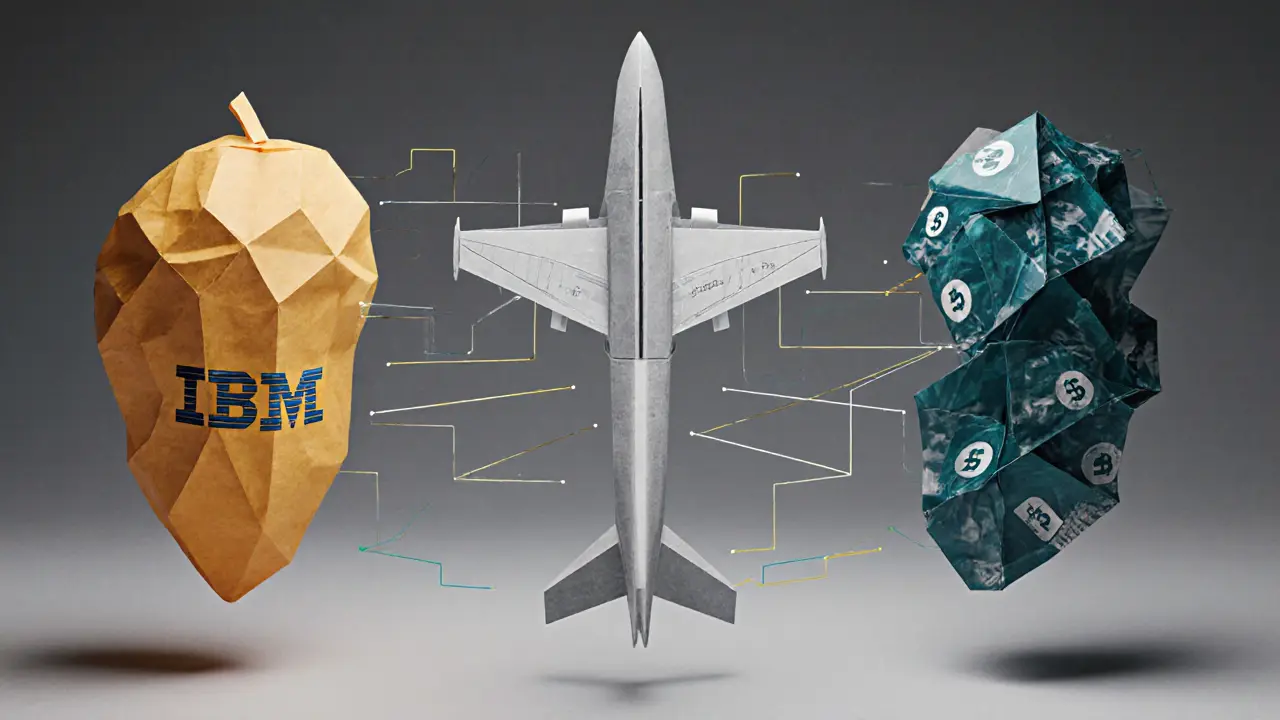Supply Chain Blockchain Platform Recommender
This tool helps you choose the most appropriate supply chain blockchain platform for your specific business needs. Based on your industry, primary problem, and business size, it will recommend one of the top platforms in 2025.
Recommended Platform
When a shipment of medicine goes missing, or a batch of spinach is recalled across three countries, how long does it take to find out where it came from? In 2018, it took seven days. Today, thanks to supply chain blockchain platforms, that same trace takes under two seconds. This isn’t science fiction-it’s happening right now in warehouses, ports, and farms around the world. The question isn’t whether blockchain belongs in supply chains anymore. It’s which platform actually works for your business.
What Makes a Supply Chain Blockchain Platform Different
Not all blockchains are created equal. Public blockchains like Bitcoin or Ethereum are open to anyone. That’s great for crypto trading, but terrible for tracking pharmaceuticals or food. Why? Because you don’t want random strangers seeing your supplier prices or shipment routes. Supply chain blockchain platforms are private, permissioned networks. Only approved companies-growers, shippers, retailers, regulators-can join. Every transaction gets recorded in a shared, unchangeable ledger. That means if a container of coffee beans leaves Colombia, every step: customs clearance, ocean transit, warehouse receipt, store delivery-is logged in real time. No one can delete or alter it. And every participant sees the same version of the truth. This isn’t just about being transparent. It’s about fixing broken processes. Before blockchain, companies relied on emails, Excel sheets, and paper bills of lading. Data got lost. Disputes took weeks. Recalls were slow and expensive. Blockchain doesn’t fix bad data-it makes bad data impossible to hide. And that changes everything.Top Three Platforms in 2025
There are over 60 supply chain blockchain platforms out there. But only three dominate real-world use:- IBM Blockchain - Built on Hyperledger Fabric, it’s the go-to for food and pharma. Walmart uses it to track mangoes from farm to shelf. Pfizer uses it to verify drug authenticity across 12 countries.
- Hyperledger Fabric - The open-source engine behind IBM’s platform. Used by manufacturers, logistics firms, and industrial suppliers. It’s customizable, modular, and integrates with SAP and Oracle.
- XDC Network - Focused on trade finance. It cuts cross-border payment delays from 10 days to under 30 seconds. Used by banks and exporters in Asia, Europe, and Latin America.
How IBM Blockchain Works in Practice
IBM Blockchain isn’t just software. It’s a network. The IBM Food Trust network includes over 200 companies: Nestlé, Carrefour, Dole, and Walmart. When a bag of lettuce is packed, a digital tag is created. That tag moves with the product. If a customer gets sick from E. coli, instead of recalling every head of lettuce in North America, they can pinpoint the exact farm, batch, and truck. That used to take a week. Now it takes 2.2 seconds. The platform also reduces paperwork. Instead of faxing certificates of analysis, suppliers upload digital versions. Smart contracts automatically verify compliance. If a shipment arrives without a temperature log, the system flags it before it’s even unloaded. For pharmaceuticals, IBM’s Transparent Supply solution cuts dispute resolution costs by 41%. Why? Because everyone sees the same data. No more arguing over who signed for what, or when.Hyperledger Fabric: The Engine Behind Industrial Supply Chains
While IBM is the face, Hyperledger Fabric is the muscle. Launched by the Linux Foundation in 2015, it’s the most flexible enterprise blockchain platform available. Its biggest advantage? You can plug in your own consensus rules. In a food supply chain, you might need every supplier to approve a transaction. In a car factory, you might only need the assembly line and parts supplier to agree. Fabric lets you design that. It also works with existing ERP systems. If your company uses SAP for inventory or Oracle for procurement, Fabric connects to them via API. No need to replace your entire tech stack. 47% of manufacturers use Hyperledger-based solutions, according to Debut Infotech’s 2025 survey. Why? Because it handles complexity. A single jet engine has 30,000 parts from 200 suppliers. Tracking each one with paper or spreadsheets is impossible. With Fabric, every part’s origin, inspection record, and maintenance history is stored permanently.
XDC Network: Speeding Up Global Trade Finance
If IBM and Fabric are for tracking goods, XDC Network is for paying for them. Cross-border trade has always been slow. Letters of credit take days to process. Banks need to verify documents manually. Payments sit in limbo. XDC solves this with a hybrid blockchain. It’s not fully public or private-it’s designed for trade. When a buyer in Germany orders machinery from India, the smart contract locks payment until shipping documents are verified and customs cleared. The moment all conditions are met, payment releases automatically. Settlement time drops from 5-10 business days to under 30 seconds. That’s not a minor improvement. It frees up working capital. Small exporters who used to wait months for payment can now reinvest faster. XDC handles over 2,000 transactions per second-far more than Ethereum’s 15-45. And it’s cheaper. Transaction fees are pennies, not dollars.Why Most Projects Fail (And How to Avoid It)
Here’s the hard truth: 60% of blockchain supply chain pilots fail. Why? Because companies think blockchain is a magic fix. It’s not. It’s a tool. And if your processes are broken, blockchain just digitizes the mess. Dr. Yossi Sheffi from MIT put it bluntly: “Blockchain solves the data sharing problem, not the data quality problem.” Common failures:- Trying to force all suppliers to join without incentives
- Not standardizing data formats (one company uses ‘kg’, another uses ‘kilos’)
- Underestimating integration costs (average $285,000 per ERP connection)
- Expecting ROI in 3 months
Real Results from Real Companies
Don’t take our word for it. Here’s what’s working:- Walmart: Reduced mango traceability from 7 days to 2.2 seconds. Cut recall investigation costs by 63%.
- Maersk (TradeLens): Processed $1.2 trillion in global trade across 300+ companies before shutting down in 2023. Proved large-scale adoption was possible.
- FedEx: Automated 76% of shipment verifications. Reduced paperwork by 68%.
- Pharma companies: 33% better forecast accuracy, 28% less documentation time.

What You Need to Get Started
You don’t need a blockchain team to begin. But you do need:- A clear problem to solve
- One or two key suppliers willing to join
- At least $150,000-$300,000 for pilot implementation
- 4-6 months for rollout
Future Trends: AI, IoT, and Digital Twins
The next wave isn’t just blockchain. It’s blockchain + AI + IoT. IBM’s 2025 update added AI-powered anomaly detection. It now spots suspicious patterns-like a refrigerated truck idling too long-before a shipment spoils. False alerts dropped by 37%. Hyperledger Fabric 3.0, released in January 2025, lets different blockchains talk to each other. That’s huge. Right now, if you use IBM and your supplier uses XDC, they can’t share data directly. New cross-chain protocols fix that. Siemens just launched a Digital Supply Chain Twin. It combines blockchain data with real-time sensor feeds from warehouses and trucks. The system predicts delays before they happen-44% more accurately than before. Gartner predicts 75% of large enterprises will use AI-blockchain combos for risk prediction by 2027. Right now, it’s only 22%.Regulations Are Pushing Adoption
Governments aren’t waiting. They’re forcing change. The U.S. FDA’s 2024 Drug Supply Chain Security Act requires full traceability for all pharmaceuticals by 2027. No blockchain? No sale. The EU’s Digital Product Passport mandates similar tracking for electronics, textiles, and batteries by 2026. Every product needs a digital ID showing origin, materials, carbon footprint, and recycling info. These aren’t suggestions. They’re legal requirements. Companies that ignore blockchain will be priced out of key markets.Final Thought: It’s Not About the Tech
The best supply chain blockchain platform won’t help if your team doesn’t trust each other. If your suppliers hide data. If your logistics partner refuses to share scans. If your accounting team still prints invoices. Blockchain doesn’t build trust. It reveals where trust is broken. The real advantage isn’t the ledger. It’s the conversation it forces. When everyone sees the same data, blame games stop. Problems get solved faster. Relationships improve. Start small. Solve one real problem. Pick the right platform. And remember: this isn’t about being futuristic. It’s about being reliable.What is the best supply chain blockchain platform in 2025?
There’s no single "best" platform-it depends on your use case. IBM Blockchain is ideal for food and pharma traceability. Hyperledger Fabric works best for complex manufacturing supply chains with ERP integration. XDC Network leads in trade finance and cross-border payments. Choose based on your industry, partners, and core problem.
Can small businesses use supply chain blockchain?
Yes, but not alone. Small businesses typically join existing networks like IBM Food Trust or XDC’s trade finance ecosystem. You don’t build the platform-you join it. Costs are shared among members. Many platforms offer entry-level tiers starting under $10,000/year for small suppliers.
How long does it take to implement a supply chain blockchain platform?
A pilot project takes 4-6 months. Full rollout across multiple partners can take 6-12 months. The timeline depends on how many suppliers need to join, how complex your data is, and whether your ERP systems can integrate easily. Most companies start with one product line to test before scaling.
Is blockchain secure for sensitive supply chain data?
Yes, enterprise platforms use military-grade security: SHA-256 hashing, elliptic curve cryptography, hardware security modules (HSMs), and role-based access control. Only approved participants can view or update data. IBM and Hyperledger Fabric are certified for compliance with ISO 27001 and GDPR.
What’s the ROI of a supply chain blockchain platform?
ROI varies, but common results include: 28-41% reduction in dispute resolution costs, 33% improvement in forecast accuracy, 50-68% less paperwork, and 60% faster recall response. Most companies see payback in 12-18 months. The biggest savings come from avoiding recalls, reducing inventory waste, and speeding up payments.
Why did Maersk shut down TradeLens?
Maersk shut down TradeLens in late 2023 not because it failed, but because it succeeded too well. The platform processed $1.2 trillion in trade and proved blockchain could work at scale. But the governance model was too centralized. Maersk and IBM couldn’t get enough third-party buy-in to make it truly neutral. The technology lived on-many companies migrated their data to other Hyperledger-based systems.
Do I need to hire blockchain developers?
Not necessarily. IBM and Hyperledger offer managed services and pre-built templates. You can start with consultants and internal supply chain teams. But for custom smart contracts or deep integrations, you’ll need developers skilled in Go (for Fabric) or Solidity (for Ethereum variants). Salaries range from $145,000-$185,000 in North America.




